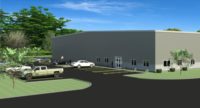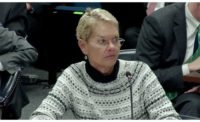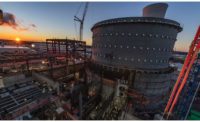Christopher Hartz is an early eyewitness to the twin projects that punctured the hope for a “nuclear renaissance” and drove Westinghouse into bankruptcy.
For 14 tumultuous months, from late 2009 to 2011, Hartz worked for Shaw Nuclear Services, the main subcontractor to Westinghouse on its new Georgia and South Carolina reactor projects. With the South Carolina project now canceled and the Georgia project billions of dollars over budget and years late, Hartz’s account of what he saw and experienced in Shaw Nuclear’s Charlotte, N.C., office provides a new channel for understanding the traumatic infancy of a slow-developing disaster.
Shaw and Westinghouse believed they could ship the first modules—based on Westinghouse’s heavily promoted new reactor design—to Georgia and South Carolina from the Lake Charles, La., fabrication plant of Shaw Nuclear’s sister company, Shaw Modular Solutions. That goal proved to be an airy fantasy. During this time, Hartz was not familiar with any schedule that included quality-related activities—a big omission considering the major problems that would envelop the work. When Hartz’s concerns about quality and compliance problems led to Shaw Nuclear shutting down work at the plant during critical months in the second half of 2010, Hartz says he and another Shaw employee were met with an angry outburst by one of the company’s senior managers. In a hastily arranged meeting at Lake Charles about the impending stop-work order, the senior manager hurled a letter opener head-high in the two men’s direction.
“I wasn’t a whistle-blower. I was just a senior procurement manager who was concerned.”
– Christopher Hartz, former Shaw Nuclear procurement quality-assurance manager
Looking back, Hartz now sees the incident as a symbol of all that was wrong in Shaw’s approach to the projects. “It was a precursor,” says Hartz. One of many, as it turned out. To build the first new nuclear reactors in the U.S. in three decades—South Carolina’s V.C. Summer Units 2 and 3 and Georgia’s Plant Vogtle Units 3 and 4—the design and construction team would face a steep learning curve. However, says Hartz, learning wasn’t much of a priority in the rush to start work at Lake Charles. “They were clueless” about the complex geometry of nuclear welds, the nuclear supply chain and the need for a nuclear safety culture, he notes, adding, “I wasn’t a whistle-blower. I was just a senior procurement manager who was concerned.”
Now 61 and retired, Hartz served as Shaw Nuclear’s procurement quality-assurance manager, overseeing the firm’s nuclear supply chain. A California resident for most of his adult life, Hartz had spent his childhood in Pittsburgh, where his father worked as a district chief of quality assurance for Stone & Webster. After moving out West, Hartz worked for 25 years at Pacific Gas & Electric’s Diablo Canyon nuclear power plant. By 2008, nuclear power seemed to be headed back to the front ranks of U.S. energy. Hartz says he was working on a graduate degree at California Polytechnic State University when Shaw was staffing up for the nuclear projects.
To be sure, Hartz’s account is just one person’s view (several former colleagues of Hartz failed to return calls requesting interviews). Although deeply critical of his former employer, Hartz doesn’t put all the blame on Shaw for what happened in 2010. But correspondence between Shaw and the Nuclear Regulatory Commission, including notices of nonconformance with NRC standards, shows there already was serious trouble with Shaw’s work in that year.
Baton Rouge-based Shaw Group, led by chief executive James Bernhard Jr., had elevated itself in the late 1990s from a profitable pipe-fabrication company supplying major industrial contractors to big prime-contracting roles on turnkey power jobs. At the time, federal subsidies to utilities encouraged new nuclear projects, and Shaw acquired the once-venerable Stone & Webster in 2000 and bought a 20% interest in Westinghouse Electric in 2006. Thus linked, the two companies tied their fate to Westinghouse’s supposedly safer and easier-to-build AP1000 pressurized water reactors with passive cooling and safety systems. Shaw touted its nuclear strategy to investors.
The construction of a nuclear power plant, especially the nuclear island, reactor vessel and containment structure, has been described as a testament to human ingenuity. The effort requires discipline, too. To finish a nuclear power plant, the project’s team must coordinate numerous hives of activity involving utilities, regulators, contractors and suppliers. Many attempts don’t succeed. Out of 177 nuclear-reactor construction projects started in the U.S., 40 were abandoned at some stage of construction, according to the Bulletin of the Atomic Scientists, an anti-nuclear association. As early as Feb. 11, 1985, an issue of Forbes magazine proclaimed, “The failure of the U.S. nuclear power program ranks as the largest managerial disaster in business history.”
Related Article: Is Georgia's Project the Nuclear Revival's Last Gasp?
Mindful of nuclear construction’s sad record, Westinghouse continued to generate sunny forecasts for the future of AP1000 nuclear reactors. Even after Hartz’s team had stopped work at Lake Charles in 2010 and the NRC had sought to clamp down on what it saw as Shaw’s lax quality control in its design-change process with Westinghouse, Westinghouse and the utilities reported optimistically about progress at the two projects. For example, at an American Society of Mechanical Engineers seminar in June 2011, Westinghouse’s module fabrication manager presented a slide show that lauded all the design’s benefits but made no mention of the developing problems. The seminar was titled “Blueprint for a Nuclear Renaissance.”
Westinghouse lacked some simple logistical sense that could have helped to finish the incomplete design, Hartz says. Westinghouse should have had engineers working at the offices of both Shaw and Westinghouse, which would have speeded up communication and helped quality, Hartz suggests.
The projects got off to a poor start. Westinghouse would issue drawings to Shaw Nuclear in Charlotte. When Shaw reviewed the drawings and asked Westinghouse to correct a detail, problems ensued. The work processes were unnecessarily complicated by the separation of the team members. Giving an example of how the process got out of hand, Hartz says that, if a design called for a 3⁄8-in.-wide, 12-in.-long fillet weld, the welder might make it 14 in. long. “Instead of having Westinghouse right there saying, ‘That’s no problem,’ ” recalls Hartz, “we had to write a nonconformance report that was processed and reviewed by Shaw and then sent to Westinghouse for disposition. It was insane. From Lake Charles to Pittsburgh to Charlotte then back to Shaw Modular before the red nonconformance tag could be taken off, saying it’s OK now.”
He adds, “Each change went through the same tortuous path, taking months and months.”
The NRC also played a role, failing, in Hartz’s view, to place inspection staff on site or close to Lake Charles, which would have sped up the communication and review process. “They should have had a resident inspector in Lake Charles and in Westinghouse’s Cranberry Township, Pa., office, near Pittsburgh, for a first-of-a kind design,” says Hartz.
The result was that the Westinghouse-Shaw relationship became toxic.
But the result was that the Westinghouse-Shaw relationship became toxic. Due to mistakes in design drawings, Shaw Modular started keeping track of the hours spent dealing with the errors with the intention of billing the cost back to Westinghouse’s Cranberry office. Mistrust simmered.
The Westinghouse concept called for several dozen types of modules to be built from submodules, created at Lake Charles and shipped to the power-plant sites, where they were to be fitted together in assembly buildings. The largest module, CA20, consisted of 72 sub-modules welded into a single structure 70 ft high and wide and weighing 1.7 million lbs. Module construction was supposed to start in February 2010, and the first CA20s were due to be finished that year, some as early as August. It was presumed that Shaw Nuclear would be purchasing modules made by Shaw Modular, an arrangement that deprived the vendor and procurement quality-control staff of the arm’s-length relationship that would have existed between two separate companies. That put Hartz in a bind. With Shaw Modular expected to be the supplier, the company needed to be on Shaw Nuclear’s qualified supplier list. Hartz says he felt tremendous pressure to approve Shaw Modular. At the time, he says he told himself that, as soon as the sister company passed an audit, he would make it an approved vendor.
Unsettling First Visits
Hartz’s initial visits to Lake Charles proved unsettling. Shaw Modular’s management personnel saw no difference between more typical industrial welds and nuclear ones, Hartz says. Talking to one of the welders and welding managers, Hartz recalls, “He’d say, ‘It’s just black iron welding,’ and I’d say, ‘No, it’s nuclear welding with very specific rules.’ ”
Since Shaw Modular had no welding standard in place, it needed to hire a degreed welding engineer with nuclear experience, in Hartz’s view. “I asked about it, and they laughed at me,” he said. Apparently, the Lake Charles management was satisfied that there was an American Welding Society (AWS) inspector, as well as other on-site welding engineers from equipment suppliers. Anticipating that some things would be fixed, Hartz granted Shaw Modular and Lake Charles conditional approval. “When they pass the audit, I thought, ‘They’ll be on the list’ ” of approved vendors, Hartz adds.
Later in spring 2010, Hartz decided to send a Shaw Nuclear team to Lake Charles to conduct a quality-assurance performance-based audit. Southern Co., one of the V.C. Summer project’s owners, also sent an inspector. Arriving in June, the 10-member team planned to work Monday through Wednesday. The team spent the three days gathering information about everything related to welding, including watching welds being made. Says Hartz, “We also talked to people buying weld rod, saw how it was stored and checked training documents and design documents.”
--------------------------------------------------------------------
More Related Articles on Nuclear Energy
>Looking Abroad at Work on Small Reactors
--------------------------------------------------------------------
“It quickly became apparent there were serious problems. There were inferior welds and untraceable weld filler material,” he says. Even worse, welders were stamping welds that they hadn’t made themselves—an infraction that ultimately prompted the NRC to penalize Shaw.
The visiting audit team gathered Wednesday afternoon to talk about what it had found. With everyone understanding the potential pitfall of work falling behind schedule if Shaw Nuclear were to exercise its stop-work authority over Shaw Modular, the audit team voted 9-1 to stop work.
To avoid springing the decision on Shaw Modular management at an exit meeting—“a professional courtesy,” says Hartz—he told some of the local managers about the vote. They were unhappy but couldn’t do anything about it. Then, Hartz and one of the Lake Charles managers went to the office of a more senior Shaw Modular manager. The senior manager “threw books and smashed a chair” before he sent flying the letter opener, Hartz claims. “It just missed.” Back in Charlotte, the procurement quality manager says he went through channels to solve “the behavior and the welding problem. All I wanted was an apology, but I never got one.”
Bombarded With Requests
Instead, he says, he was bombarded with requests to lift the stop-work order; nevertheless, Hartz says his team did not lift the order, keeping module fabrication at a standstill for the following months. The hold on all fabrication and rework at Shaw Modular lasted until the final quarter of 2010, according to a report filed by SCANA Corp., co-owner of the V.C. Summer plant in South Carolina. Eventually, Shaw Modular got Shaw Nuclear to lift the stop-work order, says Hartz, who adds that he left the job in November. And Shaw did convince the NRC that its quality-control and safety culture had been fixed.
Inspections and audits are routine in nuclear power. But the welding problems persisted beyond the 2010 hold on the work. William R. Jacobs Jr., the project monitor hired by the Georgia Public Service Commission for Plant Vogtle, testified in December 2012 that, when the steel for the submodule had been changed to require full penetration, Westinghouse and Shaw Modular failed to use the correct, code-compliant weld on certain modules. Done incorrectly, the welds needed to be repaired at the Vogtle site. The quality-assurance paperwork had so many missing signatures and illegible notes that resolution sometimes “took longer than fabrication of the submodule,” Jacobs stated.
The modular advantage proved illusory as the modules ended up being “stick-built” in Georgia and South Carolina, according to Hartz. He blames Shaw’s Bernhard for what he witnessed. “Quality comes from above. It starts with the chief executive officer,” he says. ENR did not receive replies to questions submitted to Bernhard, who now operates Bernhard Capital Partners, in Baton Rouge. Another former Shaw Module senior manager did not return a call for comment. In 2012, Shaw Group sold itself to Chicago Bridge & Iron, which, after bleeding cash trying to turn the nuclear projects around, sold those project contracts to Westinghouse. Before retiring, Hartz joined Bechtel National Inc. as a manager of procurement engineering. In 2014, he spoke at an NRC workshop on the nuclear supply chain and quality assurance.
If historians examine why the nuclear renaissance fizzled, they could cite Westinghouse’s promise that AP1000 reactors needed “a short, 36-month construction schedule” from first concrete to core load. Or they could note that Shaw was unprepared for what it faced from its partner Westinghouse and the nuclear construction industry. The glittering promise that modular design would erase much of the risk of nuclear construction turned out to be just that, a glittering promise. The V.C. Summer and Plant Vogtle projects, instead of forming the basis of a nuclear renaissance, delivered a body blow to U.S. nuclear construction as devastating as any of the disastrous nuclear projects that are already in the history books.
Editor's Note, 11/6/17: In the original version, ENR incorrectly reported Christopher Hartz's educational status. This article has been edited to provide the correct information.








Post a comment to this article
Report Abusive Comment